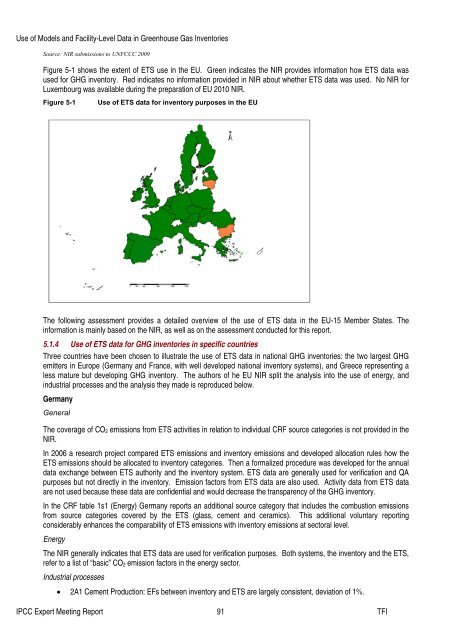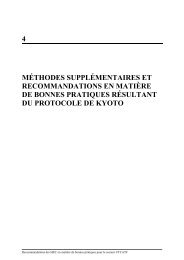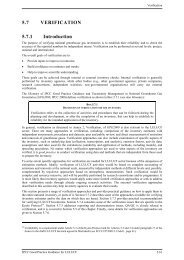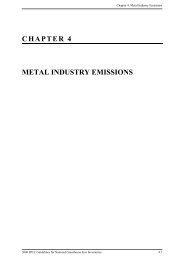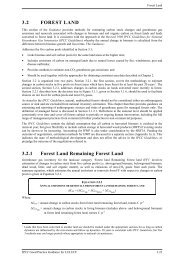Use of Models and Facility-Level Data in Greenhouse Gas Inventories
Use of Models and Facility-Level Data in Greenhouse Gas Inventories
Use of Models and Facility-Level Data in Greenhouse Gas Inventories
Create successful ePaper yourself
Turn your PDF publications into a flip-book with our unique Google optimized e-Paper software.
<strong>Use</strong> <strong>of</strong> <strong>Models</strong> <strong>and</strong> <strong>Facility</strong>-<strong>Level</strong> <strong>Data</strong> <strong>in</strong> <strong>Greenhouse</strong> <strong>Gas</strong> <strong>Inventories</strong><br />
Source: NIR submissions to UNFCCC 2009<br />
Figure 5-1 shows the extent <strong>of</strong> ETS use <strong>in</strong> the EU. Green <strong>in</strong>dicates the NIR provides <strong>in</strong>formation how ETS data was<br />
used for GHG <strong>in</strong>ventory. Red <strong>in</strong>dicates no <strong>in</strong>formation provided <strong>in</strong> NIR about whether ETS data was used. No NIR for<br />
Luxembourg was available dur<strong>in</strong>g the preparation <strong>of</strong> EU 2010 NIR.<br />
Figure 5-1<br />
<strong>Use</strong> <strong>of</strong> ETS data for <strong>in</strong>ventory purposes <strong>in</strong> the EU<br />
The follow<strong>in</strong>g assessment provides a detailed overview <strong>of</strong> the use <strong>of</strong> ETS data <strong>in</strong> the EU-15 Member States. The<br />
<strong>in</strong>formation is ma<strong>in</strong>ly based on the NIR, as well as on the assessment conducted for this report.<br />
5.1.4 <strong>Use</strong> <strong>of</strong> ETS data for GHG <strong>in</strong>ventories <strong>in</strong> specific countries<br />
Three countries have been chosen to illustrate the use <strong>of</strong> ETS data <strong>in</strong> national GHG <strong>in</strong>ventories: the two largest GHG<br />
emitters <strong>in</strong> Europe (Germany <strong>and</strong> France, with well developed national <strong>in</strong>ventory systems), <strong>and</strong> Greece represent<strong>in</strong>g a<br />
less mature but develop<strong>in</strong>g GHG <strong>in</strong>ventory. The authors <strong>of</strong> he EU NIR split the analysis <strong>in</strong>to the use <strong>of</strong> energy, <strong>and</strong><br />
<strong>in</strong>dustrial processes <strong>and</strong> the analysis they made is reproduced below.<br />
Germany<br />
General<br />
The coverage <strong>of</strong> CO 2 emissions from ETS activities <strong>in</strong> relation to <strong>in</strong>dividual CRF source categories is not provided <strong>in</strong> the<br />
NIR.<br />
In 2006 a research project compared ETS emissions <strong>and</strong> <strong>in</strong>ventory emissions <strong>and</strong> developed allocation rules how the<br />
ETS emissions should be allocated to <strong>in</strong>ventory categories. Then a formalized procedure was developed for the annual<br />
data exchange between ETS authority <strong>and</strong> the <strong>in</strong>ventory system. ETS data are generally used for verification <strong>and</strong> QA<br />
purposes but not directly <strong>in</strong> the <strong>in</strong>ventory. Emission factors from ETS data are also used. Activity data from ETS data<br />
are not used because these data are confidential <strong>and</strong> would decrease the transparency <strong>of</strong> the GHG <strong>in</strong>ventory.<br />
In the CRF table 1s1 (Energy) Germany reports an additional source category that <strong>in</strong>cludes the combustion emissions<br />
from source categories covered by the ETS (glass, cement <strong>and</strong> ceramics). This additional voluntary report<strong>in</strong>g<br />
considerably enhances the comparability <strong>of</strong> ETS emissions with <strong>in</strong>ventory emissions at sectoral level.<br />
Energy<br />
The NIR generally <strong>in</strong>dicates that ETS data are used for verification purposes. Both systems, the <strong>in</strong>ventory <strong>and</strong> the ETS,<br />
refer to a list <strong>of</strong> “basic” CO 2 emission factors <strong>in</strong> the energy sector.<br />
Industrial processes<br />
• 2A1 Cement Production: EFs between <strong>in</strong>ventory <strong>and</strong> ETS are largely consistent, deviation <strong>of</strong> 1%.<br />
IPCC Expert Meet<strong>in</strong>g Report 91 TFI


